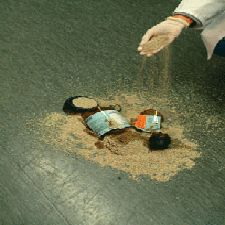Page content

Materials that must always be present
- Sufficient absorbents are in place where hazardous liquids are stored.
- Neutralizing agents when working with strong acids and strong bases.
- The right fire extinguishers.
- Suitable personal protective equipment (PPE): gloves, protective clothing, safety goggles or face shield, mouth nose mask or full face mask with filter canister.
- An emergency shower and an eye wash.
- A first aid kit with treatment and bandage material.
- Specific emergency kits in places where cytostatics are present.
- Specific kits in places where cyanide compounds and hydrofluoric acids are used.
Act according to the in-house emergency response plan
How to act if something does go wrong is stated in the emergency response plan. This can be a central plan and/or plans at department level. Important items are included are:
- How the in-house emergency response (BHV) is organized.
- Tasks and responsibilities of employees and (company) emergency response officers.
- An overview of the available materials and aids, including the places where they are located.
- Information on how safety equipment, means of repression and warning devices are periodically maintained and monitored.
- Rescuing valuable patient- or research materials.
Specifically for hazardous substances, the emergency plans may include things like:
- An overview of the storage locations.
- Rescuing gas cylinders.
- Switch offrisky equipment.
- Shutting off the gas properly.
Which incidents do you have to report and register?
Which incidents you have to report and register depends on the agreements made with the competent authority, for example the labor inspectorate or the environmental service. Coordinate in your umc how the internal reports and registrations and the reports to the authorized person are carried out. Agree on which expert will carry out the investigation in a certain type of accident.
Internal reporting
Report and record the following events only internally:
- Accidents with minor injuries and possible absenteeism.
- Incidents involving dust exposure and near misses.
- Needlestick injuries with exposure to patient material or to carcinogens (always report immediately).
Internal and external reporting
Always report the following events immediately internally and externally:
- Accidents resulting in fatality or serious bodily or mental injury (i.e. hospitalisation) or permanent injury.
- Events that may have resulted in the release of category 3 or 4 biological agents.
- Accidents involving (and release of) GMOs outside the compartmentalised areas.
- Any accident involving exposure to ionizing radiation from radioactive substances. The effective dose that the employee has received must be stated.
- Emergencies due to discharge must be reported to the competent authority via the internal procedures and the regulations indicated in the Wm or WABO permit.
By reporting accidents involving hazardous substances, an expert can conduct an investigation. Based on the examination, you will be advised measures to prevent recurrence. Take external attention into account. Having the press informed by a communication department is better than a message via multimedia channels.
Clean up broken bottle of liquid
Before you start cleaning up the substance, check what the hazard properties and health risks are. And how to clean up the substance safely. Then make sure that the right materials are available nearby to clean up the spill. Include this in the spillage protocol. If a bottle of liquid has broken, warn everyone in the room. Depending on the quantity, the laboratory can be evacuated and the emergency response team must be called in. Below you can see in a video how they quickly visualize the risks by classifying chemicals in advance via stickers on the cap:
Red sticker: evacuate (high risk of fire and inhalation)
Very volatile (p >150 hPa) and hazardous substance (category 1) in large quantities (> 500 ml)
Examples: ether, chloroform, dichloromethane.
Blue sticker: have it cleaned up (mainly dangerous for the skin)
Moderately volatile substance (p < 150 hPa), moderately hazardous (category 2 or higher), in small quantities (< 500 ml).
Examples: ethanol, methanol, NMP.
No sticker: clean up yourself (not classified as dangerous)
Solids and substances without a hazard symbol.
Examples: DMSO, salts.
If you are going to clean up yourself, use chemically resistant (double) gloves. Cover the liquid with an absorbent and dispose of it as hazardous waste. Use wet tissues or cellulose pads to remove shards and glass splinters. Clean the infected area thoroughly. In the case of very hazardous substances, hazardous substances in large quantities or if the correct absorbent agents are lacking, it is wise to call in the emergency response team immediately. Warn colleagues and leave the room if necessary and make sure that others do not enter the room again. The emergency response team can safely clean up dangerous liquids with the help of respiratory protection and with the necessary tools. Check when the emergency response needs to be alerted within your umc.
In the event of a fire, always call the emergency number first. Extinguish an incipient fire in a laboratory with a carbonation or foam extinguisher. It is better to leave the use of the fire hose to the emergency response workers who are more trained for this. A fire hose can give a jet of water or be set to spray. A high pressure water jet can cause significant damage in a laboratory and lead to the spread of varoius hazardous substances. It can even promote the fire if bottles of solvent break. Some solvents do not mix with water, so they are easily spread over a larger area with a fire hose. For classified laboratories, such as an ML-III lab, it is not allowed to extinguish with water to prevent the spread of contaminated extinguishing water.
